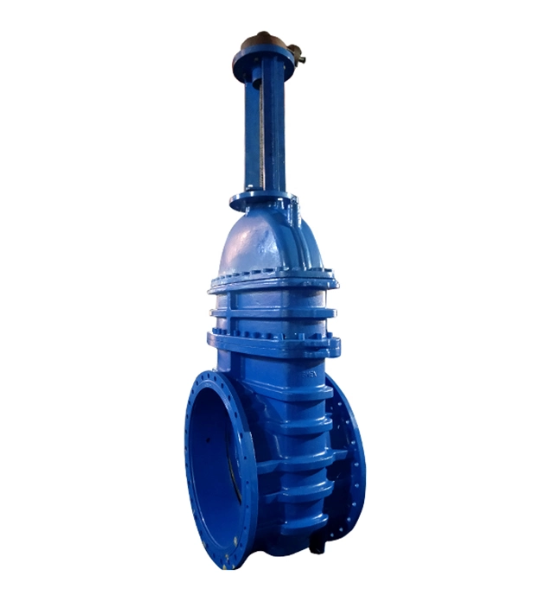
Avr 16, 2024 | Nouvelles
Les robinets-vannes sont essentiels à la régulation du débit de fluide dans de nombreuses industries, et leur fonctionnement efficace dépend d'un entretien minutieux. Ce guide décrit les méthodes et techniques de maintenance pour trois catégories de vannes: grands robinets-vannes, vannes manuelles, and cast steel gate valves.
Basic introduction to Big Size Gate Valves
Big size gate valves, also called large diameter gate valves, are designed for handling voluminous fluid flows with expansive nominal diameters.These valves are essential in various industries like oil and gas transmission, traitement chimique, la production d'énergie, traitement de l'eau, mining, and infrastructure projects. They handle high flow capacities, pressure thresholds, and large pipe diameters.
Selection & Entretien
Selection:
- Selection Considerations:Working pressure, temperature, fluid properties, flow requirements, and more are considered.
- Installation & Commissioning: Strict specifications and manufacturer’s guidance are required for the installation of big size gate valves. The valve must be correctly centered, firmly supported, and connections tightly sealed and leak-free. Functional tests and sealing tests are conducted during debugging to confirm that the valve moves flexibly, experiences no jamming, and maintains a good seal.
Entretien:
- Visual inspections should routinely be carried out to identify wear, corrosion, or damage on the cast steel gate valve.
- Suitable lubricants should be applied to the stem threads and sealing surfaces for friction reduction and smooth operation.
- Valve seals should be monitored and replaced as necessary to ensure sealing integrity and leakage prevention.
- The valve should be kept clean from debris or contaminants that might affect operation, using proper cleaning agents carefully.
- The valve’s functionality should be checked periodically, with issues like sticking or jamming addressed promptly to avoid damage.
Advantages of Manual Gate Valves in International Trade
- Adaptability to various environments: One of the characteristics of manual gate valves is their adaptability. Regardless of how adverse the conditions may be, these valves maintain their functional integrity, unaffected.
- Economic feasibility: In terms of cost management, manual gate valves are evidently favored. The initial purchase price of these valves is lower, and there is almost no energy requirement (as they do not need electricity to operate). Donc, they can help reduce operating costs for businesses – an important consideration factor on the international trade stage.
- Ease of use and maintenance: The unique thing about vannes manuelles is their simplicity.This simplicity ensures that repairs can be quickly carried out in the event of a malfunction, without the need for specialized equipment. Rapid repair turnover is crucial for preventing costly downtime in international trade operations.
- Independence from power sources: The benefits of valves that can operate without a power source cannot be underestimated. In areas with unstable power supply or frequent power outages, manual gate valves ensure the continuity of operations.
- Simple operation: Operating manual gate valves does not require extensive training or technical knowledge, making them suitable for a broader workforce. In an international context, this means fewer barriers for personnel interacting with these valves, thus making operations smoother.
- Long-term reliability: Manual gate valves are praised for their longevity. They are typically made of sturdy materials like cast steel, enduring the test of time and consistently fulfilling their duties.
- Enhanced security: In an era where digital threats are increasingly pronounced, the manual nature of these valves circumvents vulnerabilities associated with automated systems. Due to the need for physical operation, manual gate valves can effectively prevent network intrusions that might otherwise disrupt trade processes.
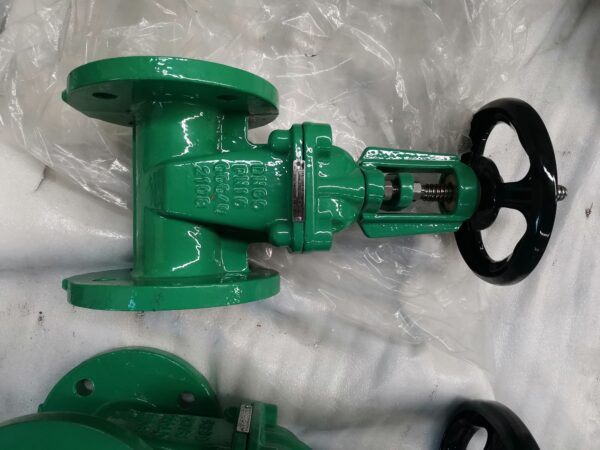
How to Maintain Manual Gate Valves ?
- Valve handles should be inspected regularly for wear, ensuring smooth operation and secure attachment.
- The packing gland should be checked and adjusted periodically to prevent stem leakage through proper compression.
- The valve body and parts should be coated or treated with anti-corrosion substances, especially when exposed to harsh elements.
- Valve stem and packing should be lubricated to ease operation and reduce friction, using condition-appropriate lubricants.
- Seals should be replaced when necessary to ensure ongoing sealing effectiveness and to guard against leaks, with material consideration for specific fluid and thermal demands.
Introduction and Repair of Cast Steel Gate Valve
At the heart of industrial fluid control lies the vanne à vanne en acier moulé, a device synonymous with strength and precision. Built to withstand the rigors of high pressure and temperature variations, these valves are the cornerstone of heavy-duty industrial applications, from steam distribution in power plants to flow control in oil refineries.So how to make cast steel gate valves last longer? The following are some ways to maintain cast steel gate valves to extend their service life:
- Valves and their components should be observed for corrosion signs, with protective measures applied to ensure longevity.
- Inspections of the valve stem should be conducted regularly, with any abnormalities remedied quickly for uninterrupted functioning.
- Integrity checks, in the form of pressure tests, should be periodically undertaken to uncover any sealing flaws or leaks.
- To preserve performance, components like seats and discs must be replaced with authentic parts when wear is detected.
- Valve operations should be checked consistently, noting and addressing any unusual sounds, vibrations, or resistances.
By adhering to these maintenance guidelines tailored to big size, manual, and cast steel gate valves, industries can ensure the reliability, efficiency, and safety of their fluid control systems, prolonging the lifespan of these critical components and minimizing downtime. Souviens-toi, regular maintenance is key to maximizing the performance and longevity of gate valves in industrial operations.
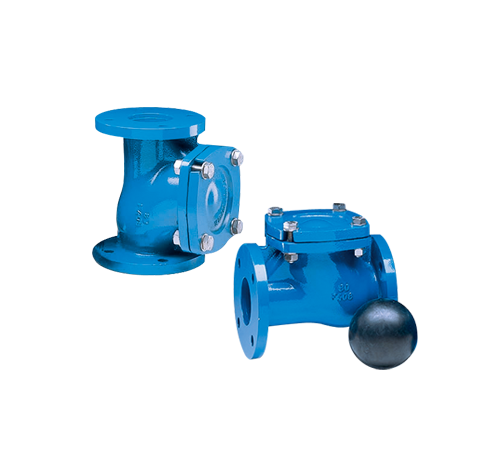
Avr 13, 2024 | Nouvelles
Clapets anti-retour à double plaque Wafer: Ces petites merveilles sont comme les agents de la circulation du flux fluide. Ces astucieuses valves sont efficaces, fiable, et essentiel pour maintenir des performances et une longévité optimales du système. Dans ce guide, we’ll explore the key factors to consider when selecting the best wafer dual plate check valve for your needs.
Understanding Wafer Dual Plate Check Valves
Imagine these valves as the gatekeepers of your fluid system. They go by different names—wafer double door check valves or dual plates check valves—but their purpose remains the same. Here’s the lowdown:
- Compact and Lightweight: Wafer dual plate check valves are like the minimalists of the valve world. They’re designed for tight spaces, making them ideal for applications where real estate is at a premium.
- Two Halves, One Mission: Picture two halves (plates) that swing open when fluid flows forward. But when the tide turns (literally), they snap shut, preventing any sneaky backflow. It’s like a synchronized dance routine, but for valves.
Key Considerations for Choosing the Right Valve
- Flow Rate and Pressure: Let’s talk numbers. First, assess your system’s flow rate and pressure requirements. You want a wafer dual plate check valve with a pressure rating that comfortably exceeds your system’s operating pressure. Safety first! Aussi, keep an eye on the flow coefficient (Cv)—it’s like the valve’s flow capacity report card.
- Material Matters: Think of your valve as a chameleon—it needs to blend in with its surroundings. Consider the fluid it’ll be handling and the environment it’ll live in. Acier inoxydable, Acier Carbone, cast iron, and various alloys are common materials. Ask yourself: Is it corrosion-resistant? Can it handle extreme temperatures? Will it play nice with the chemicals in the mix?
- Size and Fit: Size matters, especially when it comes to valves. Measure your pipe diameter and understand your flow requirements. Wafer dual plate check valves fit snugly between flanges, no extra pipe support needed. It’s like finding the perfect puzzle piece for your system.
Clapets anti-retour à double plaque Wafer: Your Fluid Flow Guardians
In the intricate world of industries, there’s a silent hero—the wafer dual plate check valve. These unassuming valves keep the fluid traffic moving in the right direction while firmly saying “no” to any sneaky backflow. Here’s why they matter:
- Efficiency and Reliability: Think of them as the backstage crew—essential but rarely in the spotlight. These valves quietly ensure optimal performance and system longevity. No drama, just results.
- Compact and Mighty: Picture a tiny superhero. That’s the wafer dual plate check valve. It fits snugly where space is tight, making it perfect for cramped setups.

In our guide, we spill the beans on how to choose the best wafer dual plate check valve. TWT Valve always can manufacture the high quality product word-widely.
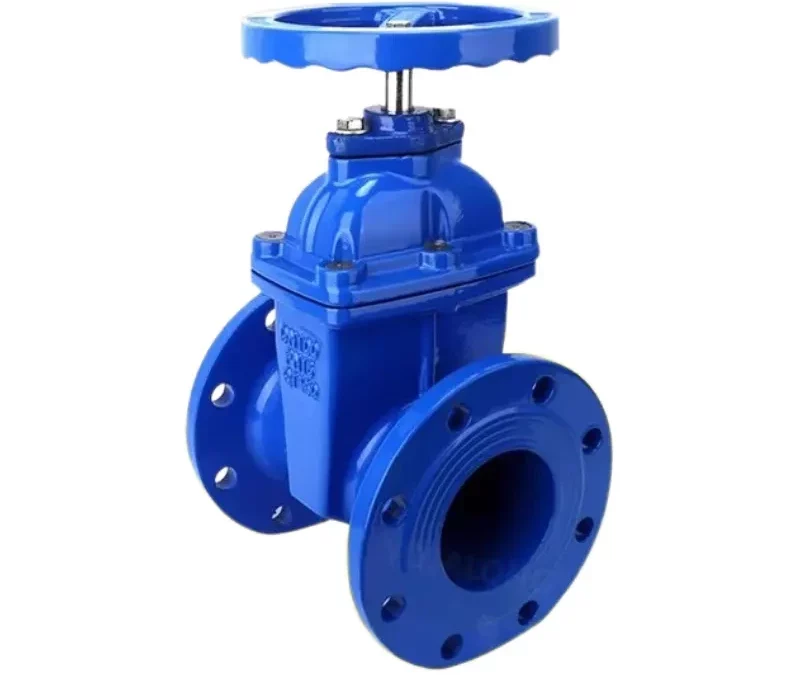
Avr 12, 2024 | Nouvelles
Chaque type de robinet-vanne possède ses propres caractéristiques uniques, presque comme des personnalités, parfaitement adapté pour relever différents défis en matière de contrôle des fluides. Dans cet article, nous embarquons dans un voyage pour découvrir les bizarreries et les capacités de ces compagnons de vannes, discovering where they shine brightest. From handling the gentle flow of water to the mighty rush of oil and gas, understanding the nuances between these gate valves is akin to mastering the art of orchestrating fluid dynamics in industrial symphonies. Let’s delve into the world of gate valves and explore the differences and applications of three distinct types: manual gate valve, robinet-vanne en fonte, and non-rising stem gate valve.
Manual Gate Valve
Conception et fonctionnement:
UN manual gate valve, also known as a knife valve or slide valve, is a linear motion valve. It features a flat closure element (the “gate”) that slides into the flow stream to provide shut-off. The valve’s operation involves moving the gate perpendicular to the flow direction. Manual actuation (usually via a handwheel) controls the gate’s position.
Avantages et inconvénients:
Avantages:
- Inexpensive and easy to maintain.
- Excellent for on-off services.
- Inherently fire-safe when used with a metal sheet.
Disadvantages:
- Poor throttling characteristics due to erosion of the seat and disk during throttling.
- Slow open and close time.
- Not suitable for sanitary applications.
Applications:
- Used in various industrial sectors, y compris le pétrole et le gaz, pharmaceuticals, fabrication, automotive, and marine.
- Ideal for slurries and viscous liquids (par exemple., heavy oils, molasses, cream).
- Wherever a reliable shutoff valve is needed.
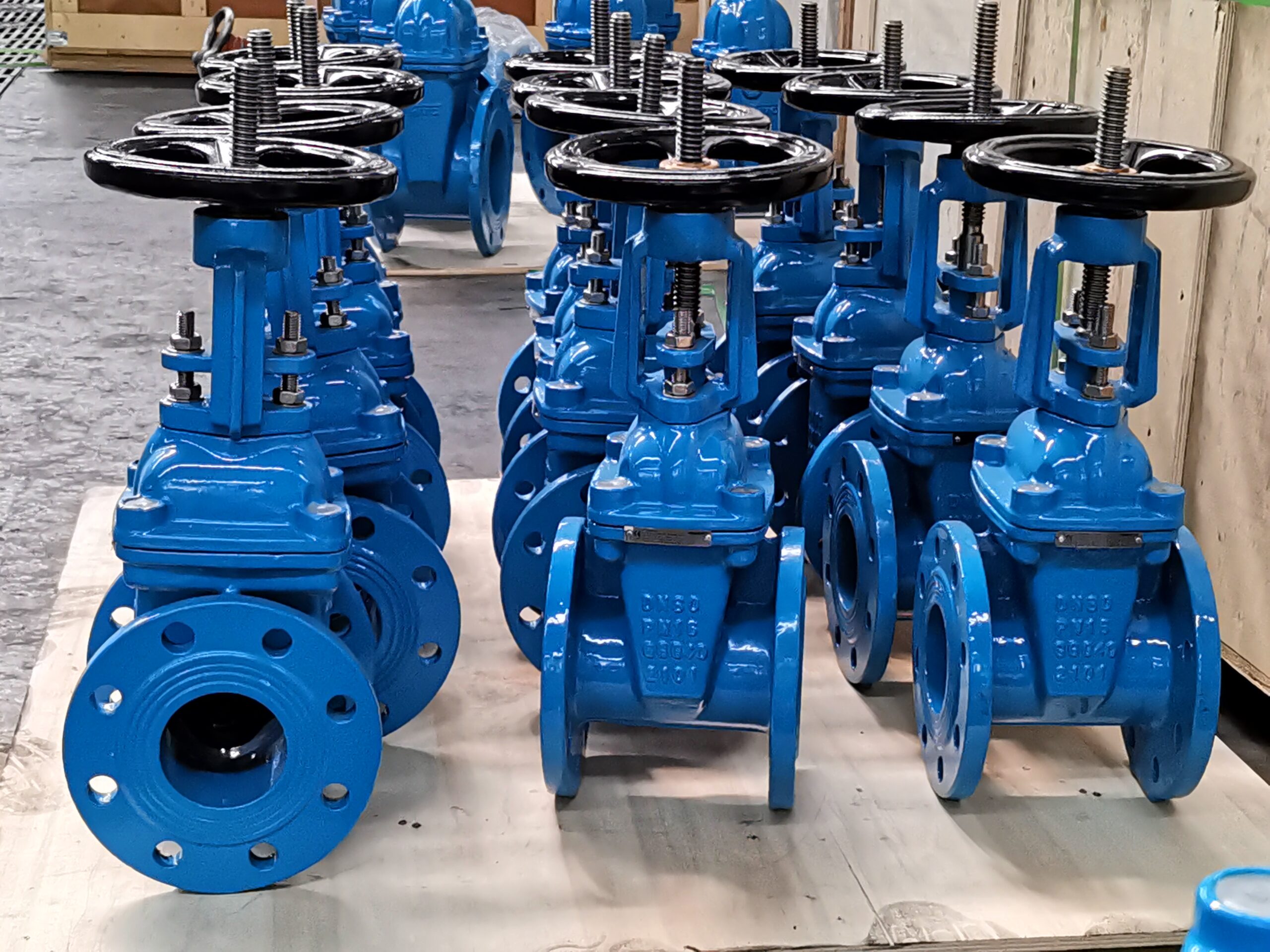
Cast Iron Gate Valve
Design and Features:
Cast iron gate valves are commonly made from ductile iron or cast iron. They come in both rising stem and non-rising stem designs. Rising stem gate valves have a stem that moves vertically during operation. Non-rising stem gate valves have a stationary stem, simplifying installation and maintenance.
Avantages et inconvénients:
Avantages:
- Space-saving design (non-rising stem).
- Suitable for underground applications and ships.
- Resilient seated versions available for water treatment.
Disadvantages:
- Limited stem lubrication (non-rising stem).
- Corrosion susceptibility (non-rising stem).
Applications:
- Cast iron gate valves find use in water treatment, wastewater management, and other industrial processes.
- Non-rising stem variants are popular where vertical space is limited.
Non-Rising Stem Gate Valve
Design and Functionality:
Unlike traditional rising stem gate valves, China non-rising stem gate valves operate differently. The stem does not move visibly during valve operation. Plutôt, it rotates within the valve body to raise or lower the gate.
Avantages et inconvénients:
Avantages:
- Space-efficient (no need for extra space above the valve).
- Easy installation and maintenance.
Disadvantages:
- Limited stem lubrication.
- Potential for corrosion.
Applications:
Widely used on ships, in underground installations, and wherever vertical space constraints exist. Suitable for applications requiring infrequent valve use.
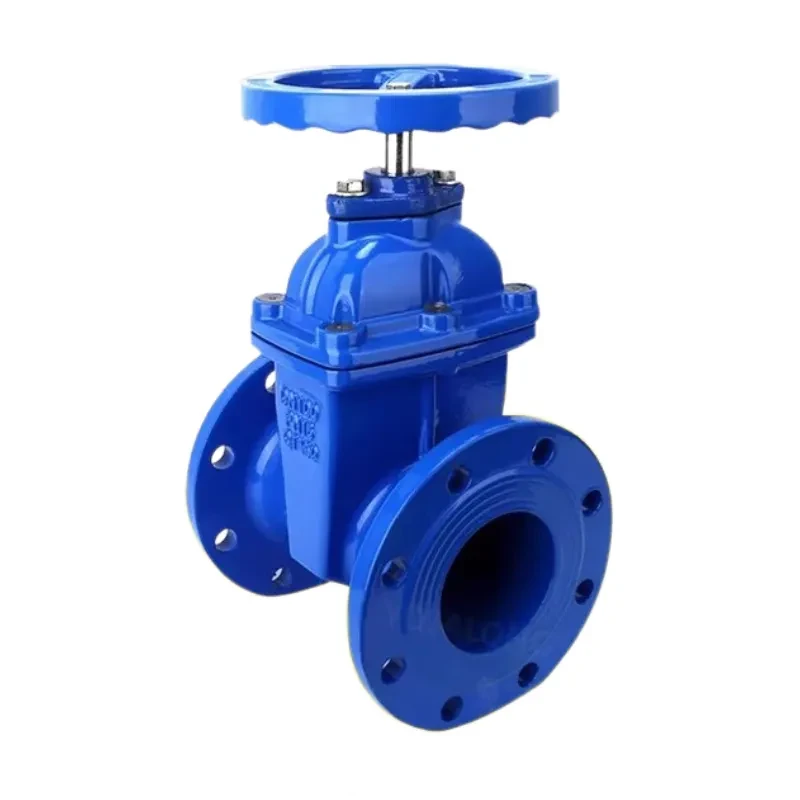
In summary, gate valves play crucial roles in various industries. Whether you need a reliable shutoff, space-saving design, or specialized features, understanding the differences between these gate valve types ensures optimal selection for your specific application needs.
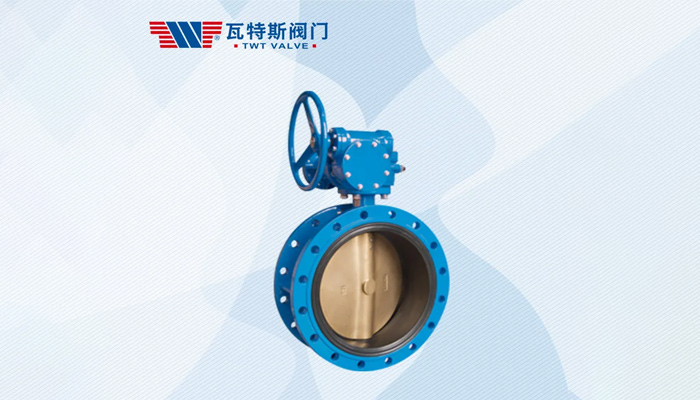
Avr 11, 2024 | Nouvelles
Step into the realm of engineering marvels with vannes papillon hautes performances (HPBV), souvent saluées comme les énigmatiques vannes papillon à double excentrage. Ces chefs-d'œuvre de la dynamique des fluides orchestrent l'écoulement dans les canalisations avec finesse et précision.. Embracing high-performance butterfly valves promises a symphony of operational enhancements, unlocking a spectrum of possibilities to optimize your fluid management endeavors.
Key aspects to enhance operations of High performance butterfly valves
Improved Process Efficiency:
Process efficiency is crucial for optimal flow capacity, minimized emissions, and reduced energy consumption. High-performance butterfly valves achieve this through several innovative features:
- Optimized Geometry: These valves are designed with field-proven technology and decades of experience. The geometry ensures smooth and efficient flow, minimizing turbulence and pressure drop.
- Reduced Energy Consumption: By minimizing flow resistance, these valves require less energy to overcome resistance. En outre, their tight shut-off design allows the use of smaller actuators, further reducing energy consumption.
- Metal Seat Technology: Unique metal seat technology minimizes leakage, improving overall system efficiency and sustainability.
Enhanced Flow Capacity:
The heart of a butterfly valve is its disc. Even when fully open, the disc remains in the middle, affecting flow capacity. High-performance butterfly valves address this:
Two-Shaft Design: In addition to the traditional one-shaft design, high-flow capacity versions with a two-shaft design optimize flow by providing more free space in the valve flow port.
Durabilité et longévité:
High-performance butterfly valves are built to withstand demanding conditions. Their robust materials and design ensure longevity, reducing maintenance costs.
Energy Efficiency:
- Reduced energy consumption due to optimized geometry and smaller actuators contributes to cost savings.
- Compressed air systems, often energy-intensive, benefit from these efficient valves.
Safety and Environmental Compliance:
- Minimized internal and external leakages enhance safety and environmental performance.
- These valves are sustainable choices, reducing the risk of failure in demanding service.
- Improved Flow Characteristics
- Reduced Wear and Tear
- Tight Shut-Off
- High-Performance Operation
- Wide Temperature and Pressure Range
- Bi-Directional Flow Capability
The eccentric design of these valves provides better flow characteristics compared to other types. The offset disc allows for a more streamlined flow of fluid, reducing turbulence and pressure drop. This results in improved flow rates and better control over fluid flow.The offset disc design minimizes wear and tear on valve components. When the valve is closed, the disc contacts only one side of the valve body, reducing friction. This extends the valve’s lifespan and reduces maintenance needs.
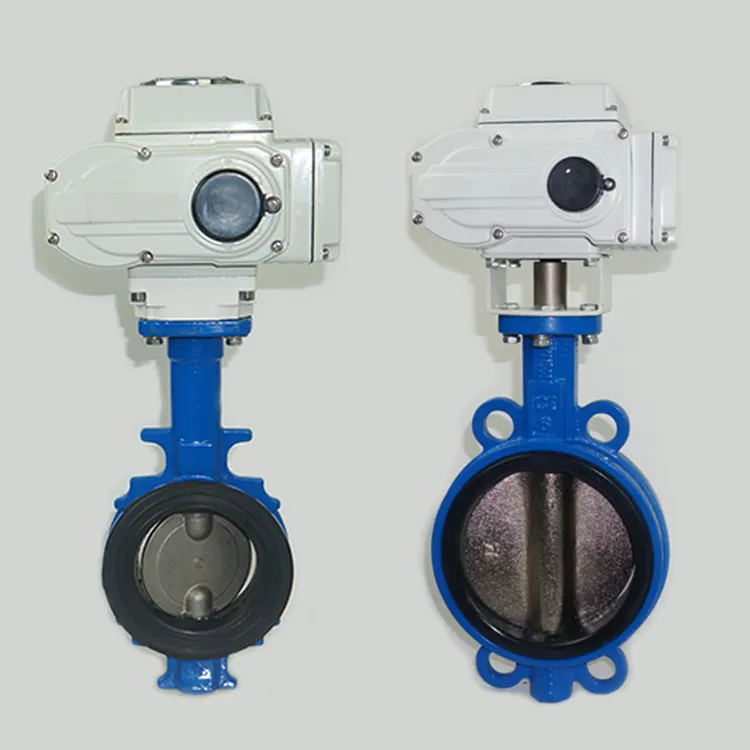
To encapsulate, the utilization of high-performance eccentric butterfly valves unveils a realm of precision, energy conservation, and heightened system efficacy. Harness the potential of these electrically-driven marvels to not only refine control but also to economize energy and bolster operational efficiency. Besides, integrate vanne papillon électrique into your operations to elevate performance standards while concurrently curbing costs.
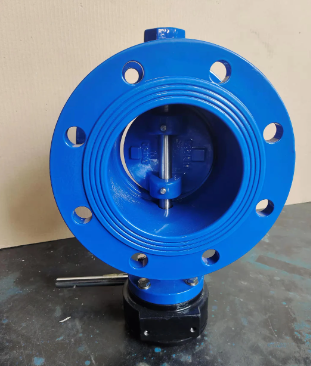
Avr 10, 2024 | Nouvelles
Les vannes papillon sont essentielles pour contrôler le débit de fluide dans diverses industries. Les types courants incluent le DI (Fonte ductile) Vanne papillon et CI (Fonte) Vanne papillon. It’s essential for those engaged in fluid management systems to grasp their features and applications. Dans cet article, we explore the characteristics and uses of both DI and CI butterfly valves, highlighting their significance in modern industry.
Fonte ductile (DEPUIS) Vanne papillon
Matériel:
Made from ductile iron, which provides enhanced strength and durability.
Conception:
Typically has a concentric disc design, with the stem aligned at the centerline of the valve body.
Applications:
- Water Supply and Distribution: Fonte ductile (DEPUIS) butterfly valves find extensive application in water treatment facilities, distribution networks, and reservoirs. They serve to regulate the flow of water, segment areas for maintenance purposes, and manage pressure levels.
- Wastewater Treatment Valves: These valves play a crucial role in managing sewage and wastewater flow within treatment facilities. They guide effluent movement throughout the treatment process.
- HVAC Systems: Fonte ductile (DEPUIS) butterfly valves are essential components in heating, ventilation, and air conditioning (HVAC) systems. They allow precise control of fluid flow within pipes, ducts, and chillers, enhancing overall system efficiency.
- La production d'énergie: Fonte ductile (DEPUIS) butterfly valves are widely used in power plants. They play a key role in managing cooling water circuits, fuel handling, and steam systems, ensuring operational efficiency and safety.
- Chemical Processing Valves: In chemical plants, these valves regulate the flow of corrosive or aggressive chemicals. Constructed from ductile iron, they possess the resilience to withstand chemical exposure, guaranteeing durability and longevity.
- Food and Beverage Industry Valves: Fonte ductile (DEPUIS) butterfly valves are ideal for handling food-grade liquids, maintaining strict hygiene standards, and preventing contamination in the food and beverage sector.
- Pharmaceutical Manufacturing: Utilized in pharmaceutical processes, DI butterfly valves provide precise control over fluids. Their durability and corrosion resistance render them valuable assets in pharmaceutical manufacturing settings.
- Ship building: DI butterfly valves serve various marine applications, including ballast systems, bilge pumps, and seawater lines.
Avantages:
- Robust construction for high-pressure applications.
- Bonne résistance à la corrosion.
- Can handle elevated temperatures.
- Limitations:
- May be more expensive than other types.
- Not always ideal for throttling services.
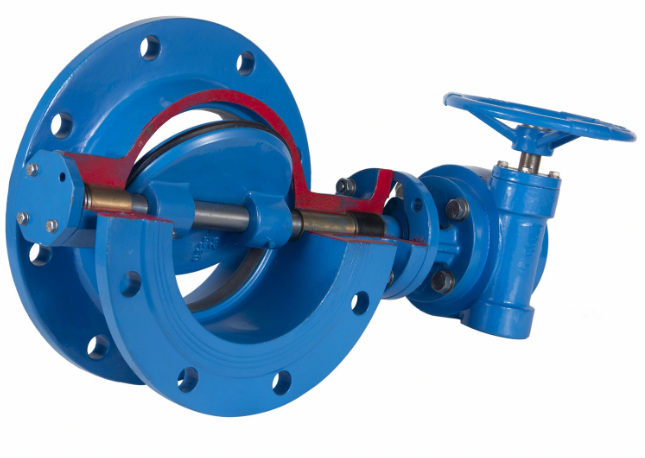
Fonte (CI) Vanne papillon
Matériel:
Made from cast iron.
Conception:
Similar to DI butterfly valves, but with cast iron material.
Applications:
- Water Supply and Distribution: CI butterfly valves regulate water flow in municipal water supply networks, réservoirs, and distribution systems. They are cost-effective and easy to install.
- Wastewater Treatment: Used in sewage treatment plants and wastewater pipelines. CI butterfly valves control the movement of effluents and prevent backflow.
- Fire Protection Systems: CI butterfly valves are essential components in fire hydrants and sprinkler systems. They quickly shut off water flow during emergencies.
- HVAC Systems: CI butterfly valves manage heating, ventilation, and air conditioning systems. They regulate fluid flow in pipes and ducts.
- Industrial Processes: CI butterfly valves serve in chemical processing, fabrication, and metal-mineral industries. They handle non-corrosive fluids and gases.
- Shipbuilding: Used in marine applications for ballast systems, bilge pumps, and seawater lines.
Avantages:
- Economical.
- Suitable for low-pressure applications.
- Good flow control capabilities.
Limitations:
- Prone to rust and requires regular maintenance.
- Not as robust as ductile iron valves.
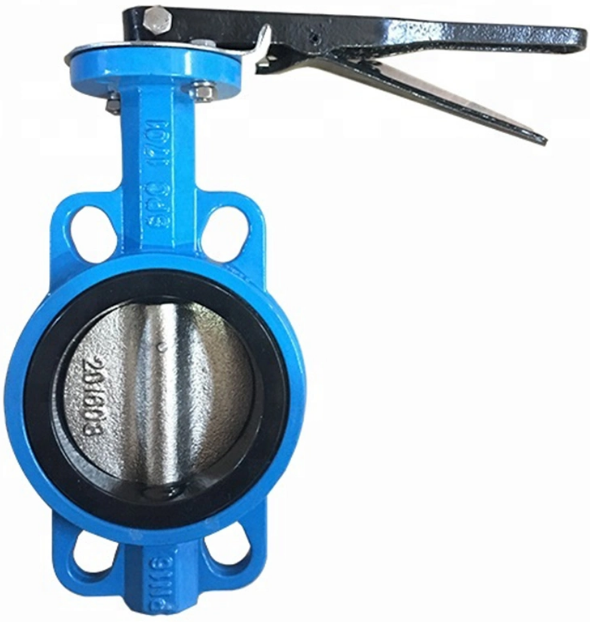
In summary, DI butterfly valves are robust and suitable for various services, while CI butterfly valves are economical but better suited for low-pressure applications. Ductile Iron wafer butterfly valves offer cost-effectiveness and ease of installation but lack end-of-line service capability. Remember to choose based on your specific project requirements!











